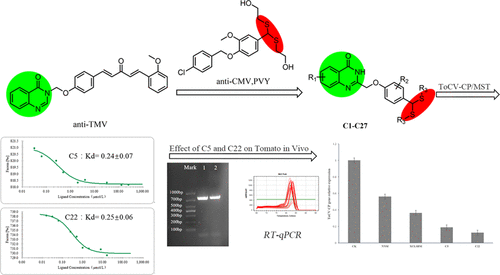当前位置:
X-MOL 学术
›
J. Agric. Food Chem.
›
论文详情
Our official English website, www.x-mol.net, welcomes your
feedback! (Note: you will need to create a separate account there.)
Design, Synthesis, and Anti-ToCV Activity of Novel 4(3H)-Quinazolinone Derivatives Bearing Dithioacetal Moiety.
Journal of Agricultural and Food Chemistry ( IF 5.7 ) Pub Date : 2020-05-08 , DOI: 10.1021/acs.jafc.0c00086 Guangcheng Zu 1 , Xiuhai Gan 1 , Dandan Xie 1 , Huanyu Yang 1 , Awei Zhang 1 , Shaoyuan Li 1 , Deyu Hu 1 , Baoan Song 1
Journal of Agricultural and Food Chemistry ( IF 5.7 ) Pub Date : 2020-05-08 , DOI: 10.1021/acs.jafc.0c00086 Guangcheng Zu 1 , Xiuhai Gan 1 , Dandan Xie 1 , Huanyu Yang 1 , Awei Zhang 1 , Shaoyuan Li 1 , Deyu Hu 1 , Baoan Song 1
Affiliation

|
Tomato chlorosis virus (ToCV) has caused great harm to the production of tomato worldwide. To develop efficient anti-ToCV agents, some novel 4(3H)-quinazolinone derivatives containing dithioacetal were designed and synthesized, and their anti-ToCV activities were evaluated by microscale thermophoresis (MST) using ToCV coat protein (ToCV-CP) as a new target. The results showed that some compounds had a strong binding capacity to ToCV-CP. In particular, compounds C5 and C22 have an excellent binding capacity to ToCV-CP, with binding constant values of 0.24 and 0.25 μM, respectively. Additionally, reduced ToCV-CP gene expression levels of 81.05 and 87.59% could be achieved when tomato was treated with compounds C5 and C22, respectively, which were obviously higher than the levels after ningnanmycin (NNM) treatment (43.88%) and lead compound Xiangcaoliusuobingmi (XCLSBM) treatment (63.56%). Therefore, this work indicates that 4(3H)-quinazolinone derivatives containing dithioacetal moiety can be used as novel anti-ToCV agents.
中文翻译:

具有二硫缩醛基的新型4(3H)-喹唑啉酮衍生物的设计,合成和抗ToCV活性。
番茄绿化病(ToCV)对全世界的番茄生产造成了极大的伤害。为了开发有效的抗ToCV药物,设计并合成了一些新型的含二硫缩醛的4(3H)-喹唑啉酮衍生物,并使用ToCV外壳蛋白(ToCV-CP)作为新的微尺度热电泳(MST)评估了它们的抗ToCV活性。目标。结果表明,某些化合物与ToCV-CP具有很强的结合能力。特别地,化合物C5和C22对ToCV-CP具有优异的结合能力,结合常数分别为0.24和0.25μM。此外,当番茄分别用化合物C5和C22处理时,ToCV-CP基因表达水平可降低81.05%和87.59%,这明显高于宁南霉素(NNM)处理后的水平(43。88%)和铅化合物香草柳索冰蜜(XCLSBM)治疗(63.56%)。因此,这项工作表明,包含二硫缩醛部分的4(3H)-喹唑啉酮衍生物可用作新型抗ToCV药物。
更新日期:2020-04-23
中文翻译:

具有二硫缩醛基的新型4(3H)-喹唑啉酮衍生物的设计,合成和抗ToCV活性。
番茄绿化病(ToCV)对全世界的番茄生产造成了极大的伤害。为了开发有效的抗ToCV药物,设计并合成了一些新型的含二硫缩醛的4(3H)-喹唑啉酮衍生物,并使用ToCV外壳蛋白(ToCV-CP)作为新的微尺度热电泳(MST)评估了它们的抗ToCV活性。目标。结果表明,某些化合物与ToCV-CP具有很强的结合能力。特别地,化合物C5和C22对ToCV-CP具有优异的结合能力,结合常数分别为0.24和0.25μM。此外,当番茄分别用化合物C5和C22处理时,ToCV-CP基因表达水平可降低81.05%和87.59%,这明显高于宁南霉素(NNM)处理后的水平(43。88%)和铅化合物香草柳索冰蜜(XCLSBM)治疗(63.56%)。因此,这项工作表明,包含二硫缩醛部分的4(3H)-喹唑啉酮衍生物可用作新型抗ToCV药物。

















































 京公网安备 11010802027423号
京公网安备 11010802027423号